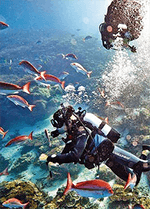
The Queensland and federal governments’ mining push is a catastrophe in the making, write Helen Caldicott and Reese Halter. The Age, February 4, 2014
The rampant destruction of the Great Barrier Reef, given the green light last Friday by the federal government, epitomises the values of our modern world.
“Economic development” and “jobs” reign supreme while our reef, one of the seven wonders of the world, a UNESCO World Heritage site, is in great jeopardy.
Home to endangered dugongs, glorious endangered sea turtles and corals, it is seething with life rich in biodiversity containing many potential medications to treat cancer and other diseases. The preservation of this unique treasure is now secondary to the voracious greed on the part of Queensland and federal governments and some individuals to export coal.
By 2030 Australia is predicted to increase its export of coal from 240 million tonnes this year to 787 million tonnes in 2030. Queensland’s liquefied natural gas and coal exports are soaring in order to deliver atmospheric-warming carbon fuels to satisfy Chinese and Indian markets.
The ports of Gladstone and Abbot Point are poised to become the busiest in the world. In 2011, the shipping industry alone increased our export trade coffers by $38 billion. In 2012, 3950 ships entered these Great Barrier Reef ports and these numbers are set to treble by 2030.
A war is being conducted against nature on our reef. All countries by international law are required to protect and preserve rare or fragile ecosystems as well as the habitat of depleted, threatened or endangered species. But in Queensland since the 1960s the plant-eating dugong population has plummeted by over 97 per cent in the quest to feed ravenous energy markets and to promote urban coastal growth. Dugongs depend on sea-grass meadows to provide them with food. Those saline meadows also offer crucial habitat for a wide array of plants and other sea life, including sea turtles.
This fecund zone is of cardinal importance for not only cycling nutrients that sustain all coastal sea-life, but it protects the reef from land-based toxicity that enters the sea. The reef’s magnificent natural shield has been impregnated. The acidification of the ocean as a result of global warming further compromises the structure of the corals.
Then there is the problem of noise. The Queensland and federal governments are aware that noise pollution can have a detrimental effect on oceanic wildlife including all the biological processes that take place within the reef itself. Whales, dolphins, sea turtles and dugongs are at risk from noise pollution as they incur cardiovascular and autoimmune stresses. Animals ranging from blue whales to the coral clown fish cease feeding and noise pollution prevents mating.
Yet no government noise regulation has been imposed on industry to curtail the final death knell for Earth’s greatest reef. The 2012 United Nations World Heritage meeting in Paris warned of the deadly consequences associated with increasing noise pollution associated with shipping, sub-sea construction and the use of exploratory sonar which causes mass stranding of whales and dolphins. The UN convention on Law Of The Sea states that all countries are to lessen under-sea noise pollution, including vessel noise and sub-sea construction equipment.
But as well as noise pollution, the ongoing damage is extraordinary. To create three liquefied natural gas terminals on Curtis Island near Gladstone, 21 million tonnes of material were dredged. This irreparably destroyed the seabed, enormous plumes of sediment were released, fish were killed en masse and the bund wall containing land-dumped dredging was breached, causing a vast toxic algal bloom. Meanwhile, Environment Minister Greg Hunt has authorised the Abbot Point port to dredge 3 million tonnes from the seabed to create six new coal ship berths.
These developments signal the beginning of ongoing massive port constructions adjacent to the Great Barrier Reef. And what are we doing in the face of this catastrophe?
We are devastating an extraordinarily beautiful natural wonder so we can heat up the planet and in the process destroy many forms of life.
Originally published: http://www.theage.com.au/comment/great-barrier-reef-on-brink-of-devastation-in-relentless-quest-for-coal-20140203-31x6q.html
Thank you, Helen, for your lifelong commitment to Earth’s environmental safety -a true steward of this fragile planet and it’s people, animals (land-based and aquatic). I just wish others (e.g., governments and companies) were not continually greedy for money, and willing to destroy on such a mammoth scale, and forget about the hindmost; and the future. Saw the interview on One on One (ABC1) this week.
Regards,
Lorraine